Basketball Defense - 1-3-1 Zone Defense
By Dr. James Gels, From the Coach’s Clipboard Basketball Playbook"Helping coaches coach better..."
Disclosure: This page contains affiliate links, which means that Coach's Clipboard receives a small commission (at no cost to you) if you make a purchase using these links.

The 1-3-1 zone defense has the advantage of being able to apply pressure on the outside arc and high post, and allows for some trapping. The major weakness is when the offense attacks from the corners and into the low post. Coaches may differ on who covers what, but you have to decide what is best for your team and teach your players how to shift, cover and defend. Rebounding can also be a problem with only one low defender. See Zone Rebounding.
The diagrams below show how the zone shifts and players move. There are two ways of playing the zone: (1) a conservative zone with less gambling and trapping, and (2) a more aggressive, trapping defense (which requires quick athletic players).
The top three defenders X1, X2 and X3 (diagram A) should be quick, athletic. X4 also needs to cover a lot of territory. Your actual player numbers (assignments) could be different depending on your personnel. X5 is your strong post defender. The basic rules are:
- X5 plays the offensive post player man-to-man, denying him the ball (fronting most of the time).
- The wing defenders X2 and X3 must drop to the weak-side block when the ball is on the opposite wing.
- X4 stays even or below the block. When the ball moves to a wing, X4 moves out about halfway to the corner.
Conventional, more conservative 1-3-1 zone defense
Diagram A shows the basic setup. X1 on the top, X2 and X3 on the wings (near the arc, free-throw line extended), X5 on the post player, and X4 down low. The arrows show how the defenders generally move in the zone. X2 and X3 are moving vertically up and down as the ball moves, while X1 and X4 move laterally, sideways with ball movement. X5 just follows his man, denying the pass. These are general guidelines, and players must always remember that the ball is the most important thing, and they must communicate. Most offenses will set up with a two guard offense, a 2-1-2 set (diagram B).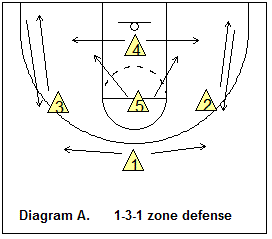
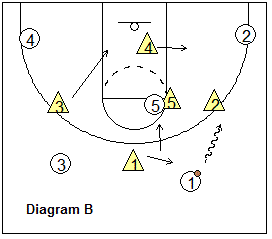
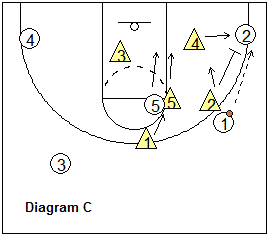
Diagram B. As the ball crosses half-court, X1 directs the ball to one side, to the awaiting wing defender X2 who then takes the ball. X1 drops toward the high post. X4 moves sideways, outside the paint. The opposite wing X3 drops to the weak-side block to give inside help. X5 is denying.
If the ball is passed to the corner (diagram C), X4 closes-out on the ball and X2 can either drop inside a little, or trap the corner with X4. X5 goes with his man O5 and denies the pass inside. X1 drops to the ball-side elbow, and the zone now looks like diagram D.
In diagram D, the ball is passed back out to the wing. X1 will initally cover the ball until X2 can get there, and then X1 will slide over more toward the top. X4 drops back toward (but not in) the paint. X5 denies the post player.
On ball-reversal (diagram E), X1 follows the ball and contains until X3 can get there. (X1 might anticipate and intercept this pass, and get a lay-up on the other end). X3 sprints out and closes-out on the ball on the wing. The opposite wing X2 drops down to the weak-side block to give inside help. X4 sprints across ball-side, again just a little outside the paint. X5 denies the post. The zone now looks like diagram F.
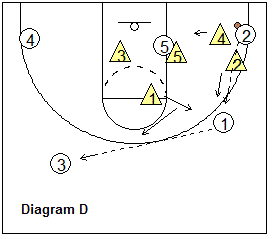
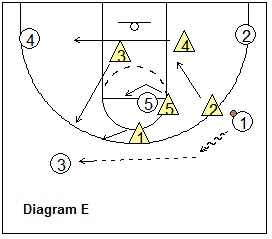
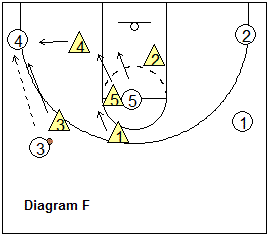
As the ball is passed to the corner (diagram F), X4 closes-out on the ball. X3 can either trap or drop inside. X1 drops to the ball-side elbow. X5 denies the post player. X2 gives help down low, but has weak-side responsibility. Now the zone looks like diagram H.
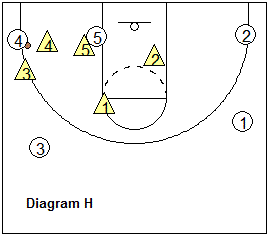
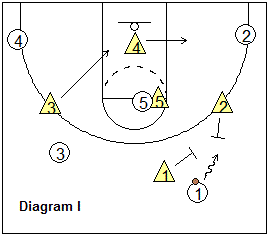
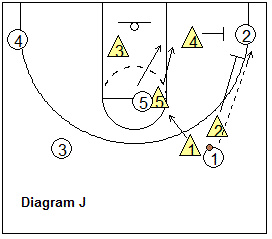
Trapping, more aggressive 1-3-1 zone defense
This trapping zone defense is more aggressive and puts pressure on the wings, as we look to trap the wings and the corners... (more in the members section)See the complete article in the members section.
Sign up now!
The complete article also includes:
- Aggressive trapping 1-3-1 zone defense.
Related pages:
- 1-3-1 Matchup Zone Defense
- Principles of Zone Defense
- Zone Rebounding
- 2-3 Zone Defense
- Aggressive 2-3 Zone Defense
- Breakdown Drills for Teaching the 2-3 Zone Defense
- 1-2-2 zone defense (and 3-2)
- Amoeba Defense
- Point-Zone Defense
- Match-up zone defense